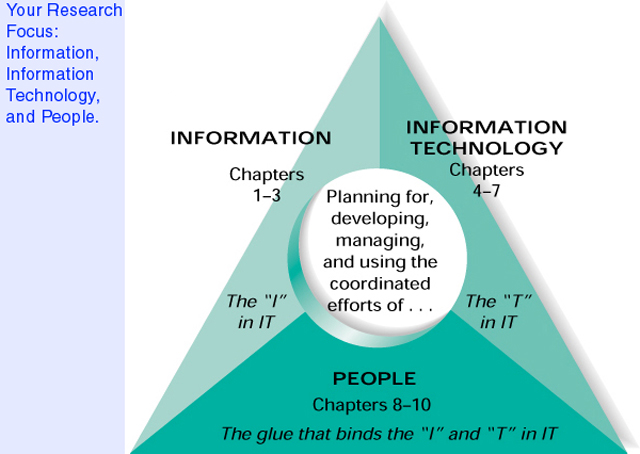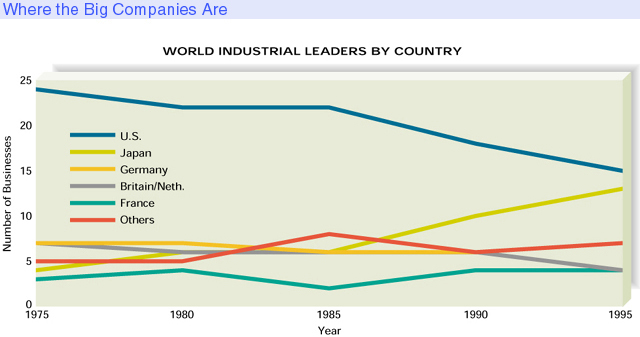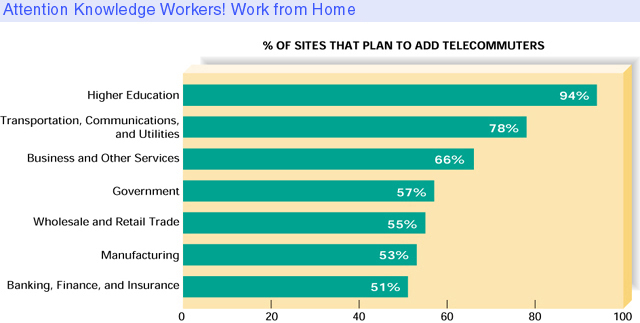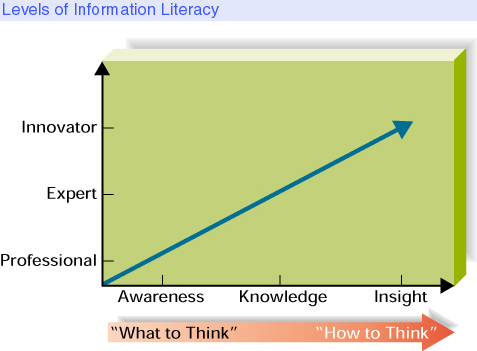Chapter 1
THE INFORMATION AGE IN WHICH YOU
LIVE
Changing the Face of
Business
Haag et al.
We Are in the Information Age. A Time
When...
- Knowledge is power
- Knowledge workers outnumber all other workers
by a 4 to 1 margin
A KNOWLEDGE
WORKER works with and produces information
as a product. As a knowledge worker, how do you work with and produce
information?
YOUR FOCUS IN THIS CHAPTER
- Management Information Systems &
The MIS Challenge
- Factors Shaping Business Today
- The Role of IT in the Information Age
- Information as a New Business Resource
- Your Role as a Knowledge Worker
MANAGEMENT INFORMATION SYSTEMS (MIS)...
deals with the planning for, development,
management, and use of information technology tools to help people
perform all tasks related to information processing and
management.
MIS Deals with Three Important Organizational
Resources:
- Information
- Information technology
- People (the most important).
Can you find those 3 resources for the
organizations in Photo Essay 1-1 on pages 6-7?
THE MANAGEMENT INFORMATION SYSTEMS
CHALLENGE
- What businesses do
- Customer moment of value
- The role of information technology
All businesses must strive to meet The MIS Challenge. The complete
MIS Challenge is
in Figure 1.1 on page 5.
THE ROLE OF INFORMATION TECHNOLOGY
Information technology (IT) is a set of tools that
can help provide the right people with the right information at the
right time.
REMEMBER: What you
don't know may put you out of business.
HOW THIS BOOK ADDRESSES MIS & THE MIS
CHALLENGE
- The Information Resource
- The "I" in IT.
- Chapters 1 - 3
- The Information Technology Resource
- The "T" in IT.
- Chapters 4 - 7
- The People Resource
- The glue that binds the "I" and "T" in
IT.
- Chapters 8 - 10

FACTORS SHAPING BUSINESS TODAY
- Globalization
- Competition
- Information as a Key Resource
- The Virtual Workplace and Telecommuting
- Electronic Commerce
- Knowledge Worker Computing
GLOBALIZATION
- Few businesses today are wholly
domestic.
- There are 260 million consumers in the
U.S.
- There are 5 billion consumers
world-wide.
A TRANSNATIONAL
FIRM is a firm that produces and sells
products and services in countries all over the world.

COMPETITION
- It's everywhere.
- Globalization has increased
competition.
- IT helps small firms compete against larger
ones.
- Competition is good for consumers.
INFORMATION AS A KEY RESOURCE
- We are in the information age.
- Knowledge is
power.
- You must know your competition.
- You must know your customers.
- We operate in a wants-driven economy. So, you
have to know
what people want.
THE VIRTUAL WORKPLACE AND TELECOMMUTING
Among the various ways to restructure, many
organizations are choosing to create a virtual workplace and/or have
their employees telecommute.
Both of these concepts are very similar.
- VIRTUAL WORKPLACE - a technology-enabled workplace. No walls or
boundaries. Work anytime, anyplace, linked to other people and
information.
- TELECOMMUTING -
the use of communications technology to work in a place other than
a central location. A person who works via telecommuting is called
a TELECOMMUTER.
SOME TELECOMMUTING STATISTICS
- Over 15 million people in the U.S.
telecommute.
- That number is expected to grow by 20% for
several years.
- Every industry is planning to increase their
use of telecommuting (Figure 1.5 page 15).
Would you rather telecommute or drive through
traffic everyday to work?
ELECTRONIC COMMERCE
A modern methodology that addresses the use of
information technology as an essential enabler of business.
EXTERNAL ELECTRONIC COMMERCE - the use of IT to support how a business interacts with
the marketplace.
INTERNAL ELECTRONIC COMMERCE - the use of IT to support internal processes, functions,
and operations.
Electronic Commerce Includes:
- Transactions over the Internet.
- Transactions through electronic data
interchange (EDI).
- Gathering customer and competitor information
(competitive intelligence).
- Distributing information
electronically.

KNOWLEDGE WORKER COMPUTING
Places technology, technology power, software,
information, and technology knowledge in the hands of those who need
it - knowledge workers.
Technology knowledge
is most important. To participate in knowledge worker computing, you
must learn how to use technology.
INFORMATION TECHNOLOGY AND ITS ROLE IN THE
INFORMATION AGE
INFORMATION TECHNOLOGY is any computer-based tool that people use to work with
information and support the information and information-processing
needs of an organization.
Businesses Use Information Technology in 3
Ways:
- To support information-processing
tasks.
- As an enabler of innovation.
- As a collapser of time and space.
TO SUPPORT INFORMATION-PROCESSING TASKS
- CAPTURING
information - at its point of origin.
- CONVEYING
information - in its most useful form.
- CREATING
information - to obtain new information.
- CRADLING
information - for use at a later time.
- COMMUNICATING
information - to other people or another location.
AS AN ENABLER OF INNOVATION
- IT is not innovation all by itself.
- IT, however, can enable innovation.
- FedEx used IT to build customer-oriented
tracking software.
What other examples of IT innovation can you think
of?
AS A COLLAPSER OF TIME AND SPACE
- A typical CD-ROM can hold 650 million
characters of information. That's:
- 325,000 pages of text, or
- 650 500-sheet reams of paper.
- In early 1999, the typical home computer was
capable of performing 450 million instructions per second. How
fast are they today?
INFORMATION AS A NEW BUSINESS RESOURCE
Information is a key resource in The MIS Challenge. But what is
information?
DATA - are any raw
facts or observations that describe a particular phenomenon.
INFORMATION - is
simply data that has a particular meaning within a specific
context.
DIMENSIONS OF INFORMATION - DEFINING VALUE
You can determine the value of information by
evaluating its dimensions.
- TIME DIMENSION -
the "when" aspect of information.
- CONTENT DIMENSION - the "what" aspect of information.
- FORM DIMENSION -
the "how" aspect of information.
DIMENSIONS OF INFORMATION
See Figure 1.6 page 21
|
|
- CONTENT- what
- Accuracy
- Relevance
- Completeness
|
|
YOUR ROLE AS A KNOWLEDGE WORKER
To be successful today as a knowledge worker, you
need to understand:
- The true nature of information (its
dimensions).
- How to be an information-literate knowledge
worker.
- Your ethical responsibilities of working with
information.
AN INFORMATION-LITERATE KNOWLEDGE WORKER
- can define what information is needed
- knows how and where to obtain
information
- understands the meaning of information
- can act appropriately on information to
achieve the greatest advantage.
In all instances, he or she uses information
according to legal and ethical constructs.
As a Knowledge Worker, You Have 5 Charges
- Define what information you need.
- Know how and where to obtain
information.
- Understand the meaning of information.
- Act appropriately based on information.
- Use information adhering to both legal and
ethical constructs.
- Charges #1-4 relate to how you use information
for the benefit of your organization.
- Charge #5 relates to using information in a
socially responsible way.
- This relates to ETHICS - sets of principles
or standards that help guide behavior, actions, and
choices.
- Ethics are often different from laws.
- Laws require or prohibit some action on your
part.
- Ethics are more of a matter of personal
interpretation.
- What may be ethical to one person is not
necessarily to another.
- As an information-literate knowledge worker,
your actions with respect to using information should always be
both legal and ethical.

TO SUMMARIZE
- We are indeed in the information age.
- All businesses must coordinate their use of
IT, information, and people (The MIS Challenge).
- The many forces shaping business today
include:
- Globalization
- Competition
- Information as a key resource
- The virtual workplace and
telecommuting
- Electronic commerce
- Knowledge worker computing.
TO SUMMARIZE
- Businesses are using information technology
(IT) in three ways:
- to support information-processing
tasks
- as an enabler of innovation
- as a collapser of time and space
- Information is also a key resource in business
today. The value of information can be defined according to its
dimensions:
- Time (when)
- Content (what)
- Form (how)
TO SUMMARIZE
Finally, people are the most important resource in
any organization. As an information-literate knowledge worker, you
have 5 charges:
- Define what information you need
- Know how and where to obtain
information
- Understand the meaning of information
- Act appropriately based on information
- Use information legally and ethically




